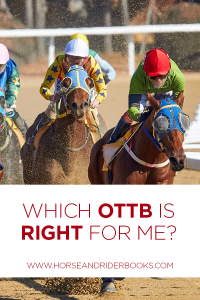
Tomorrow is the day we celebrate those oh-so-special loves in our lives. For some of us, that means extra hours at the barn with you-know-who. But others might still be looking for Mr. Right. If an OTTB has ever caught your fancy, you’re not alone…off-track Thoroughbreds are a fabulous way to do right by a horse while getting incredible athleticism in an affordable package. And OTTBs can be a great fit for whatever kind of riding you like best. Just check out our OTTB Matchmaker tips below from Anna Ford, Thoroughbred Program Director at New Vocations Racehorse Adoption. Her book BEYOND THE TRACK has been called “breakthrough racehorse literature,” “superior,” “a winner,” and “the ultimate in training manuals.”
Here are Ford’s recommendations for finding your OTTB match:
If you intend to purchase a horse off the track or adopt one through a program, I recommend you engage the assistance of an experienced friend or trainer to help ascertain the horse’s suitability for you and your discipline. Even if you buy and sell horses all the time, a second opinion is always of value.
The most important step is to ask yourself what level of riding or competition you aspire to, as many OTTBs are athletic enough to pursue any discipline at the lower levels, and most minor injuries will hold up after proper time off. With this in mind, here are a few additional guidelines to consider when evaluating OTTBs. These are generalized suggestions—there is a lot more to consider when choosing a horse for a specific discipline. And note, the examples pictured here are right off the track. Appearance changes with added weight and muscle.
The Event Horse or Jumper*

Conformation
High shoulder point (the front of the shoulder is high, with a steeply angled humerus from there to the elbow; this ensures scope over large jumps).
Uphill build.
Medium bone structure (extremely fine bone structure is less likely to hold up).
Short- to medium-length back.
Short- to medium-length pasterns (long pasterns tend to break down).
Well-set knees (horses that have knees that bend slightly forward or back, instead of straight, can place increased strain on tendons and ligaments).
Event horses can range in height. Note that larger horses (in height and mass) can be more difficult to keep sound as they are harder on their legs and feet.
 Movement
Movement
Event horses need to be very athletic with fluid gaits. Prospects should have more action at all three gaits than, say, a hunter (see below). This often indicates it will be easier for them to move with impulsion in the dressage ring and that they will pick up their knees better over fences.
Personality
Brave ∙ Athletic ∙ Hard-Working
Event prospects need to be bold, brave, and forward-going horses that have good endurance. Many of these horses could also be described as “proud” or “arrogant.” More energetic horses are often possibilities—as long as they are mentally sane and have a good work ethic, the extra energy is beneficial on the cross-country course.
*A jumper prospect will be very similar in build, action, and personality to an event horse. When looking for a jumper, put more emphasis on a stronger hind end and shoulder. A jumper does not necessarily need to be built uphill, but he should have a high shoulder point.
The Hunter

Conformation
Long, sloping shoulder.
Neck ties in well with the withers and shoulder.
Small, attractive head.
Flat topline.
Movement
Hunters should be light on their feet and have as little action in their legs as possible. A long, low, rhythmic stride that easily covers a lot of ground is desirable. The horse’s head carriage should be long and low.
Personality
Easygoing ∙ Consistent ∙ Stylish
Hunters are judged on rhythm, style, and manners. They need to be calm in nature and consistent in gait and attitude as they move around the ring and over fences.
The Dressage Horse

Conformation
Withers set back from the shoulder.
Short back.
Uphill build.
Strong, well-built hindquarters.
Neck ties in well with the withers and shoulder (avoid ewe-necked horses).
Neck should be medium to long.
Movement
The horse should naturally engage and drive from his hind end. A regular, even, four-beat walk is ideal. At the trot he should demonstrate natural impulsion and extension while remaining light on his feet. Look for a canter that is not overly “large”—a shorter stride is easier to maneuver around the dressage arena and eventually teach clean flying lead changes.
Personality
Hard-Working ∙ Sensitive ∙ Sensible
A dressage prospect should be a sensitive yet sensible horse. He needs to be very responsive to leg, seat, and rein aids rather than dead-sided or hard-mouthed. He cannot become overwrought every time he is confronted with a new task—the ideal horse likes to work and accepts new challenges eagerly.
 For more guidance in how to choose the right OTTB and transition him from the track to the ideal riding partner, check out BEYOND THE TRACK, available now from the TSB online bookstore, where shipping in the US is FREE.
For more guidance in how to choose the right OTTB and transition him from the track to the ideal riding partner, check out BEYOND THE TRACK, available now from the TSB online bookstore, where shipping in the US is FREE.
CLICK HERE for more information or to order.
Trafalgar Square Books, the leading publisher of equestrian books and DVDs, is a small business based on a farm in rural Vermont.
